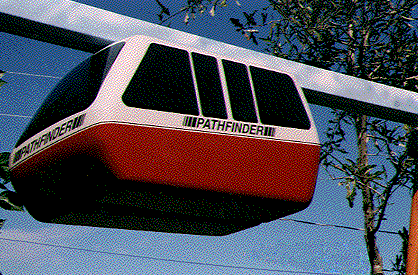Pathfinder Infopage
 Pathfinder is a PRT-scale concept that is currently under
development. Low cost and simple but rugged design are two
primary objectives of the developers. It features 4-5
passenger vehicles that are suspended from an elevated
guideway. guideway. It would provide demand-responsive
service, 24-hours a day under all weather conditions and a
computer would be used for routing and control purposes.
Pathfinder would be powered by energy-efficient batteries and
would be very quite in operation. Its guideway is small and
would and not present difficult visual intrusion problems.
Battery charging would be provided at stations which can be
off-line and could be elevated or located at ground level.
The capacity of a single guideway is estimated to be a
maxiumu of 3,600 vehicles per hour. A widespread network is
envisioned so that multiple dispersed origins and
destinations can be served with non-stop service that is
safe, reliable and as private as the user wants it to
be.
Pathfinder is a PRT-scale concept that is currently under
development. Low cost and simple but rugged design are two
primary objectives of the developers. It features 4-5
passenger vehicles that are suspended from an elevated
guideway. guideway. It would provide demand-responsive
service, 24-hours a day under all weather conditions and a
computer would be used for routing and control purposes.
Pathfinder would be powered by energy-efficient batteries and
would be very quite in operation. Its guideway is small and
would and not present difficult visual intrusion problems.
Battery charging would be provided at stations which can be
off-line and could be elevated or located at ground level.
The capacity of a single guideway is estimated to be a
maxiumu of 3,600 vehicles per hour. A widespread network is
envisioned so that multiple dispersed origins and
destinations can be served with non-stop service that is
safe, reliable and as private as the user wants it to
be.
The vehicle would provide seats for four adult
passengers and could also be configured for freight. It would
be suspended from a drive train located inside the guideway
and would be self-leveling on grades. User friendly controls
would be provided as would wheel-chair accessibility. The
vehicle would be powered by two direct-drive,
battery-powered, low friction motor wheels that would ride on
a smooth surface inside the guideway. The batteries would be
automatically recharged in the stations or when idle.
Fully-charged, the vehicle could operate for as much as four
hours. Inside the vehicle, a passenger would select a
destination from a panel. The vehicle would be routed and
controlled by an on-board computer which would insure a safe
separation between adjacent vehicles at all times. The
guideway would be an enclosed steel box beam 14" by
18" with a 2" slot on its underside. Passive
sensors would monitor vehicle speed and position. It would
contain no moving parts and the interior would be protected
from moisture and debris. Support columns could be either
steel or concrete and could be designed to meet local
conditions and aesthetic desires.
Off-line stations would allow vehicles to make non-stop
trips from origin to destination. The could be ground level,
elevated or located inside buildings as appropriate. The
would be sized to meet expected maximum demand levels during
peak-periods.
A central operations facility would be provided to
allocate vehicles as needed and would transmit and receive
performance data from each vehicle. It would provide
emergency response services. A maintenance facility would
provided to clean and maintain the vehicles.
An artist's sketch of a dual direction Pathfinder system
is shown below. A full-scale mock-up of the vehicle has been
completed -
click here to see it .
![[artist's sketch]](path1.gif)
More detailed information on the Pathfinder
concept can be obtained as follows:
Dick Hill , President, CEO and Chairman of the Board,
Pathfinder Systems, Inc., 725 South Adams Road, 242A,
Birmingham, Michigan 48009, Ph: (248) 645-0401; Fax: (248)
645-2697
Last modified: December 6, 1998
 Pathfinder is a PRT-scale concept that is currently under
development. Low cost and simple but rugged design are two
primary objectives of the developers. It features 4-5
passenger vehicles that are suspended from an elevated
guideway. guideway. It would provide demand-responsive
service, 24-hours a day under all weather conditions and a
computer would be used for routing and control purposes.
Pathfinder would be powered by energy-efficient batteries and
would be very quite in operation. Its guideway is small and
would and not present difficult visual intrusion problems.
Battery charging would be provided at stations which can be
off-line and could be elevated or located at ground level.
The capacity of a single guideway is estimated to be a
maxiumu of 3,600 vehicles per hour. A widespread network is
envisioned so that multiple dispersed origins and
destinations can be served with non-stop service that is
safe, reliable and as private as the user wants it to
be.
Pathfinder is a PRT-scale concept that is currently under
development. Low cost and simple but rugged design are two
primary objectives of the developers. It features 4-5
passenger vehicles that are suspended from an elevated
guideway. guideway. It would provide demand-responsive
service, 24-hours a day under all weather conditions and a
computer would be used for routing and control purposes.
Pathfinder would be powered by energy-efficient batteries and
would be very quite in operation. Its guideway is small and
would and not present difficult visual intrusion problems.
Battery charging would be provided at stations which can be
off-line and could be elevated or located at ground level.
The capacity of a single guideway is estimated to be a
maxiumu of 3,600 vehicles per hour. A widespread network is
envisioned so that multiple dispersed origins and
destinations can be served with non-stop service that is
safe, reliable and as private as the user wants it to
be.![[artist's sketch]](path1.gif)